In-depth understanding of MySQL index structure
This article brings you relevant knowledge about mysql, which mainly introduces related issues about the index structure. So, what is the structure of the index? Why can indexing be so fast? Let’s take a look at it below, I hope it will be helpful to everyone.

Recommended learning: mysql tutorial
Database storage unit
First of all, we need to know that in order to achieve persistence ization, the index can only be stored on the hard disk. When querying through the index, I/O operations on the hard disk will occur. Therefore, when designing the index, it is necessary to reduce the number of searches as much as possible, thereby reducing I/O time-consuming.
In addition, you need to know a very important principle: the basic unit of database management storage space is Page (Page), and multiple row records (Row) are stored in one page.
The computer system will do read-ahead optimization for disk I/O. When an I/O is performed, in addition to the data at the current disk address, adjacent data will also be read. In the memory buffer pool, the data read by each I/O becomes one page. InnoDB's default page size is 16KB. 
64 consecutive pages form an Extent, one or more extents form a Segment, and one or more segments formTablespace. InnoDB has two table space types. Shared table space means that multiple tables share one table space. Independent table space means that the data and indexes of each table are all stored in independent table spaces.
The structure of the data page is as follows (Source: Geek Time "MySQL Must Know"): 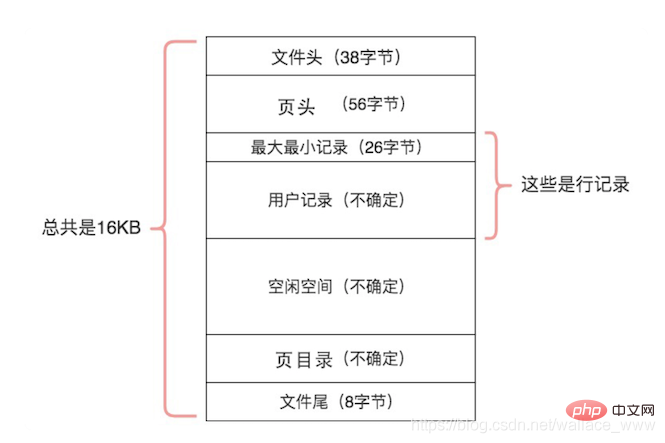
The 7 structural contents of the data page can be roughly divided into the following three categories:
- General part of the file, used to verify the completeness of page transmission
- File Header: expresses page information. FIL_PAGE_PREV and FIL_PAGE_NEXT are used in the file header to form a two-way linked list, respectively. Points to the previous and next data pages.
- File Header: Record the status information of the page
- File Trailer: Verify whether the page is complete
- Record part , used to store data records
- Maximum and minimum records (Infimum/Supremum): virtual row records, representing the maximum record and minimum record of the data page.
- User Record and Free Space: used to store data row record content
- Index part, used to improve record retrieval efficiency
- Page Directory: The relative location where user records are stored
For details, please refer to Taobao’s database kernel monthly report
Index data Structure
Naturally, we will think of some common data structures involved in search algorithms, such as binary search trees, binary balanced trees, etc. In fact, Innodb’s index uses B Tree is implemented. Let’s take a look at why this index structure was chosen.
Limitations of Binary Tree
Let’s briefly review the definition of Binary Search Tree. In a binary search tree, if the key to be found is greater than the root node, then in Search in the right subtree. If the key is smaller than the root node, search in the left subtree until the key is found. The time complexity is O(logn). For example, the sequence [4,2,6,1,3,5,7] will generate the following binary search tree: 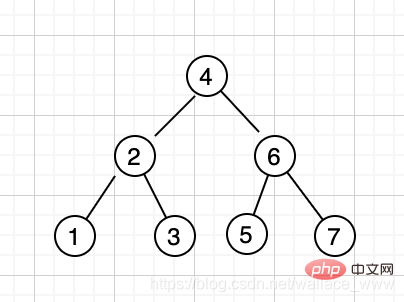
However, in some special cases, the depth of the binary tree will be very large. For example, [1,2,3,4,5,6,7] will generate the following tree: 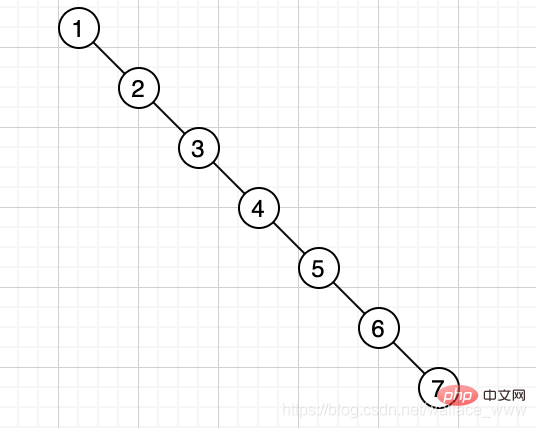
In the following situation, in the worst case, it takes 7 times to check. The desired results can be found, and the query time becomes O(n).
In order to optimize this situation, there is a balanced binary search tree (AVL tree). An AVL tree refers to a tree in which the height difference between the left and right subtrees does not exceed 1. The search time complexity is O(logn) , this is already an ideal search tree, but in a database with tens of millions of rows of records, the depth of the tree will still be very high, and it is still not the most ideal structure.
B tree
So, if you expand from a binary tree to an N-ary tree, it is easy to imagine that the N-ary tree can greatly reduce the depth of the tree. In fact, the 4-layer tree structure is It can already support dozens of terabytes of data.
B-tree (Balance Tree) is such an N-ary tree. B-tree is also called B-tree, which satisfies the following definition:
Let k be the degree of B-tree (degree, representing each The maximum number of child nodes a node can have),
- Each disk block contains at most
k - 1keywords andkpointers to child nodes - In leaf nodes, only keywords , there is no child node pointer
- The keywords in each node are arranged in ascending order. All keywords in the left subtree of each keyword are smaller than it, and the keywords in the right subtree are smaller than it. All keywords are greater than it.
- All leaf nodes are on the same layer.
As mentioned above, each I/O will pre-read the data of a disk block, which is one page in size. The content of a disk block is used to represent an I/O. The structure of the B-tree is as follows Picture (Source: Geek Time SQL must know): 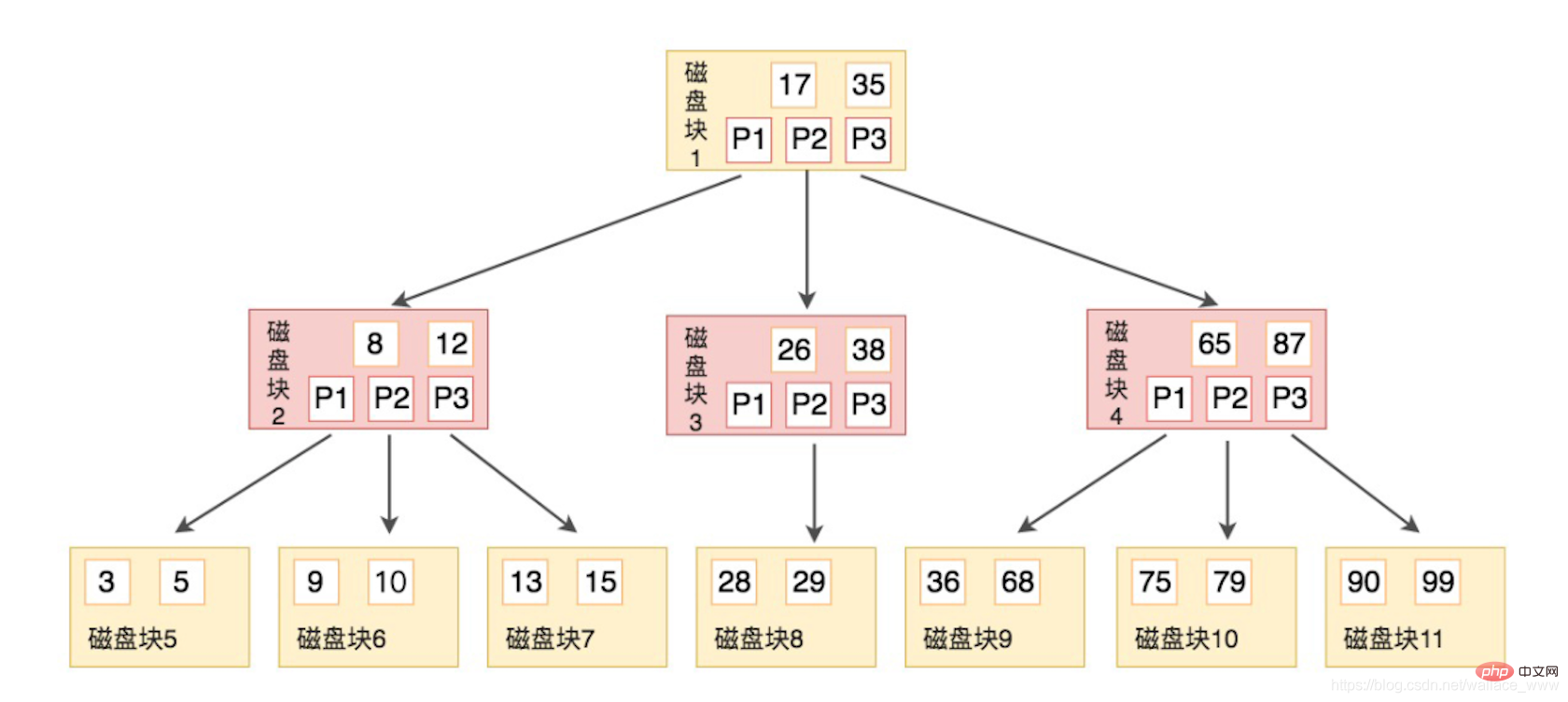
The B tree is also ordered. Since the child node pointer must be 1 more than the keyword, it can be divided into sub-trees by keywords. The section of the node, as in the example in the figure, each node has 2 keys and 3 child nodes, such as disk block 2, the key of the first byte point is 3, 5 is less than its first child node 8 , the second child node's 9, 10 are between 8 and 12, the third child node's value 13, 15 is greater than its own second child node 12.
Suppose we want to find 9 now, the steps are as follows:
- Compare with the root node disk block 1 (17,35), it is less than 17, continue to search in the pointer P1, the corresponding disk Block 2
- is compared with disk block 2 (8,12), it is located between the two, continue to search at pointer P2, corresponding to disk block 6
- and disk block 6 (9, 10) Compare and find 9
. You can see that although many comparison operations have been performed, due to pre-reading, the comparison within the disk block is performed in memory and does not consume disk. I/O, the above operation only requires 3 I/O times to complete, which is already an ideal structure.
B-tree index
B-tree is further improved on the basis of B-tree. The differences between B-tree and B-tree are as follows:
- The way the B-tree is constructed is that, for the keywords in the parent node, all the keywords of the left subtree are less than it, and all the keywords of the right subtree are greater than or equal to it.
- Non-leaf nodes are only used for indexing, No data records will be stored
- The keywords of the parent node will also appear in the child nodes, and they are the maximum values (or minimum values) in the child nodes
- All keywords will appear in Among the leaf nodes, the leaf nodes form an ordered linked list, sorted from small to large.
The example is as follows. In this example, the keywords of the parent node are the minimum values among the child nodes (Source: Geek Time SQL must know): 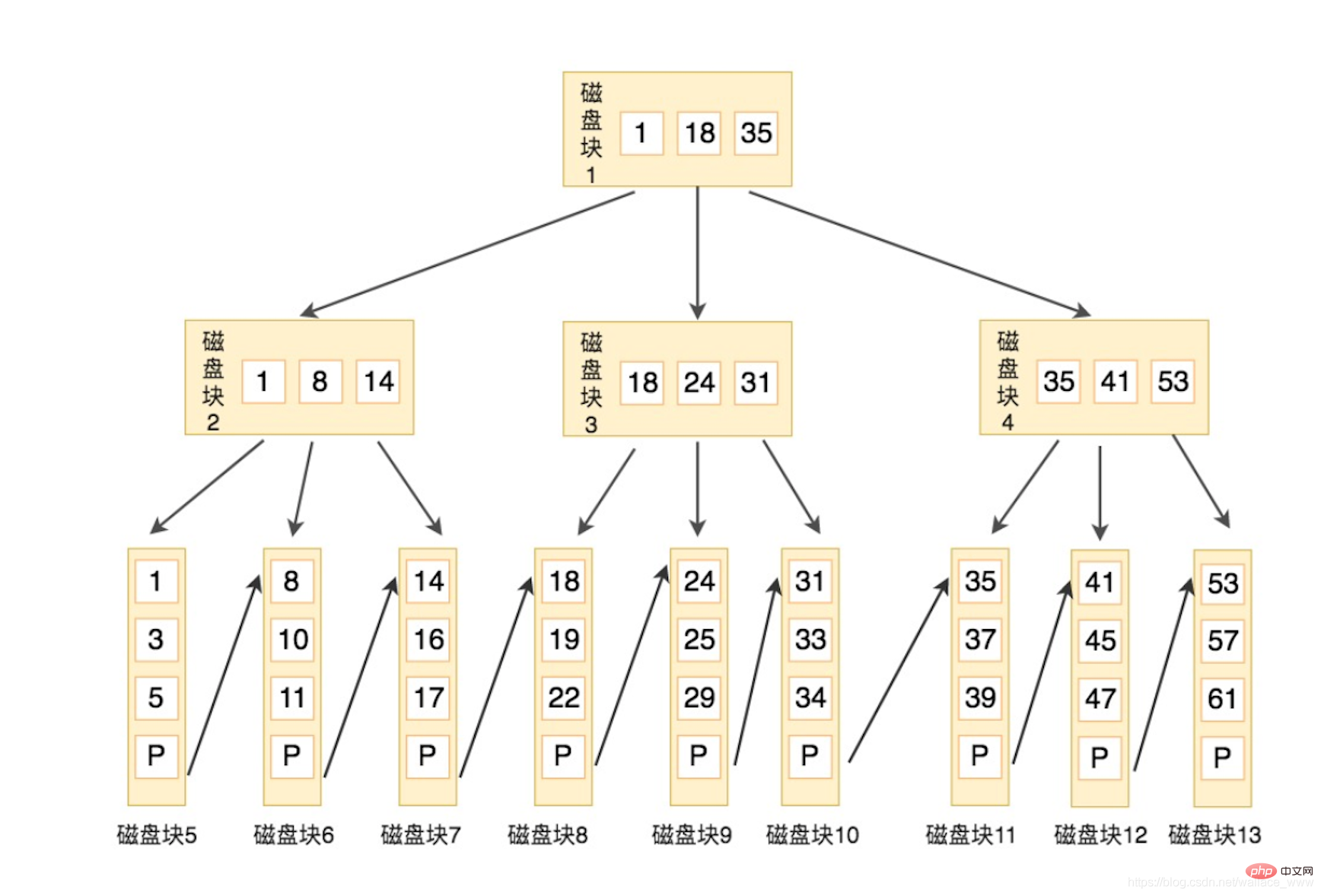
Assumption To find the keyword 16, the search steps are as follows:
- Compare with the root node disk 1 (1,18,35), 16 is between 1 and 18, get the pointer P1, pointing to disk 2
- Find disk 2 (1,8,14), 16 is greater than 14, get pointer P3, pointing to disk 7
- Find disk 7 (14,16,17), find 16
Advantages of B tree:
- Internal nodes do not store data, so the number of records that each internal node can store is much larger than that of B tree. The height of the tree is lower and I/O is less. The data page read every time I/O has more content
- Can support range query, just traverse the ordered linked list composed of leaf nodes
- All data is stored in the leaf nodes , so the query efficiency is more stable
HASH index
The default index structure of MySQL's memory storage engine is the Hash index. Hash is a function called a hash function, which is passed through a specific Algorithms (such as MD5, SHA1, SHA2, etc.) convert input of arbitrary length into output of fixed length. Input and output correspond one to one. This article will not give an in-depth introduction to the hash function. For details, please refer to Baidu Encyclopedia.
Hash search efficiency is O(1), which is very efficient. Python's dict, golang's map, and java's hash map are all implemented based on hash. Key-Value databases such as Redis are also implemented. Implemented by Hash.
For precise searches, Hash indexes are more efficient than B-tree indexes, but Hash indexes have some limitations and are therefore not the most mainstream index structure.
- Because the data pointed to by the Hash index is unordered, the Hash index cannot be range-queried, nor does it support ORDER BY sorting.
- Since Hash is an exact match, fuzzy queries cannot be performed.
- Hash index does not support the leftmost matching principle of joint index, and joint index only takes effect when there is a complete match. Because the Hash index calculates the Hash value by merging the indexes and then calculating the Hash value together, instead of calculating the individual Hash value of each index.
- If the indexed field has many duplicate values, it will cause a large number of hash conflicts, and the query will become very time-consuming.
Based on the above reasons, the Mysql InnoDB engine does not support Hash index, but there is an adaptive Hash index function in the memory structure. When an index value is used very frequently, it will be in B Based on the tree index, automatically creates a Hash index to improve query performance.
Adaptive Hash index can be understood as a kind of "index of indexes". The Hash index is used to store the page address in the B-tree index and quickly locate the corresponding leaf node. It can be viewed through the innodb_adaptive_hash_index variable.
Recommended learning: mysql tutorial
The above is the detailed content of In-depth understanding of MySQL index structure. For more information, please follow other related articles on the PHP Chinese website!

Hot AI Tools

Undresser.AI Undress
AI-powered app for creating realistic nude photos

AI Clothes Remover
Online AI tool for removing clothes from photos.

Undress AI Tool
Undress images for free

Clothoff.io
AI clothes remover

Video Face Swap
Swap faces in any video effortlessly with our completely free AI face swap tool!

Hot Article

Hot Tools

Notepad++7.3.1
Easy-to-use and free code editor

SublimeText3 Chinese version
Chinese version, very easy to use

Zend Studio 13.0.1
Powerful PHP integrated development environment

Dreamweaver CS6
Visual web development tools

SublimeText3 Mac version
God-level code editing software (SublimeText3)

Hot Topics
 1386
1386
 52
52
 MySQL: Simple Concepts for Easy Learning
Apr 10, 2025 am 09:29 AM
MySQL: Simple Concepts for Easy Learning
Apr 10, 2025 am 09:29 AM
MySQL is an open source relational database management system. 1) Create database and tables: Use the CREATEDATABASE and CREATETABLE commands. 2) Basic operations: INSERT, UPDATE, DELETE and SELECT. 3) Advanced operations: JOIN, subquery and transaction processing. 4) Debugging skills: Check syntax, data type and permissions. 5) Optimization suggestions: Use indexes, avoid SELECT* and use transactions.
 How to open phpmyadmin
Apr 10, 2025 pm 10:51 PM
How to open phpmyadmin
Apr 10, 2025 pm 10:51 PM
You can open phpMyAdmin through the following steps: 1. Log in to the website control panel; 2. Find and click the phpMyAdmin icon; 3. Enter MySQL credentials; 4. Click "Login".
 MySQL: An Introduction to the World's Most Popular Database
Apr 12, 2025 am 12:18 AM
MySQL: An Introduction to the World's Most Popular Database
Apr 12, 2025 am 12:18 AM
MySQL is an open source relational database management system, mainly used to store and retrieve data quickly and reliably. Its working principle includes client requests, query resolution, execution of queries and return results. Examples of usage include creating tables, inserting and querying data, and advanced features such as JOIN operations. Common errors involve SQL syntax, data types, and permissions, and optimization suggestions include the use of indexes, optimized queries, and partitioning of tables.
 How to use single threaded redis
Apr 10, 2025 pm 07:12 PM
How to use single threaded redis
Apr 10, 2025 pm 07:12 PM
Redis uses a single threaded architecture to provide high performance, simplicity, and consistency. It utilizes I/O multiplexing, event loops, non-blocking I/O, and shared memory to improve concurrency, but with limitations of concurrency limitations, single point of failure, and unsuitable for write-intensive workloads.
 Why Use MySQL? Benefits and Advantages
Apr 12, 2025 am 12:17 AM
Why Use MySQL? Benefits and Advantages
Apr 12, 2025 am 12:17 AM
MySQL is chosen for its performance, reliability, ease of use, and community support. 1.MySQL provides efficient data storage and retrieval functions, supporting multiple data types and advanced query operations. 2. Adopt client-server architecture and multiple storage engines to support transaction and query optimization. 3. Easy to use, supports a variety of operating systems and programming languages. 4. Have strong community support and provide rich resources and solutions.
 MySQL's Place: Databases and Programming
Apr 13, 2025 am 12:18 AM
MySQL's Place: Databases and Programming
Apr 13, 2025 am 12:18 AM
MySQL's position in databases and programming is very important. It is an open source relational database management system that is widely used in various application scenarios. 1) MySQL provides efficient data storage, organization and retrieval functions, supporting Web, mobile and enterprise-level systems. 2) It uses a client-server architecture, supports multiple storage engines and index optimization. 3) Basic usages include creating tables and inserting data, and advanced usages involve multi-table JOINs and complex queries. 4) Frequently asked questions such as SQL syntax errors and performance issues can be debugged through the EXPLAIN command and slow query log. 5) Performance optimization methods include rational use of indexes, optimized query and use of caches. Best practices include using transactions and PreparedStatemen
 MySQL and SQL: Essential Skills for Developers
Apr 10, 2025 am 09:30 AM
MySQL and SQL: Essential Skills for Developers
Apr 10, 2025 am 09:30 AM
MySQL and SQL are essential skills for developers. 1.MySQL is an open source relational database management system, and SQL is the standard language used to manage and operate databases. 2.MySQL supports multiple storage engines through efficient data storage and retrieval functions, and SQL completes complex data operations through simple statements. 3. Examples of usage include basic queries and advanced queries, such as filtering and sorting by condition. 4. Common errors include syntax errors and performance issues, which can be optimized by checking SQL statements and using EXPLAIN commands. 5. Performance optimization techniques include using indexes, avoiding full table scanning, optimizing JOIN operations and improving code readability.
 Monitor Redis Droplet with Redis Exporter Service
Apr 10, 2025 pm 01:36 PM
Monitor Redis Droplet with Redis Exporter Service
Apr 10, 2025 pm 01:36 PM
Effective monitoring of Redis databases is critical to maintaining optimal performance, identifying potential bottlenecks, and ensuring overall system reliability. Redis Exporter Service is a powerful utility designed to monitor Redis databases using Prometheus. This tutorial will guide you through the complete setup and configuration of Redis Exporter Service, ensuring you seamlessly build monitoring solutions. By studying this tutorial, you will achieve fully operational monitoring settings




